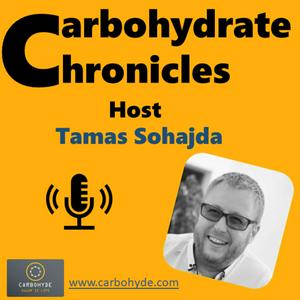Beschikbare afleveringen
5 van 23
- Carbohydrate Chronicles - The Hidden Market Power of CyclodextrinsCyclodextrins – tiny molecular rings with a massive footprint in today’s healthcare and beyond.In this episode, we take a closer look at the cyclodextrin industry: where it stands today, how it’s evolving across pharmaceuticals, nutraceuticals, and food, and why global demand is steadily on the rise.We’ll unpack market trends, real-world applications, and the opportunities shaping the future of this fast-growing field.Join us for a short market outlook on one of the most versatile tools in modern science and business.--------15:01
- Curcumin and cyclodextrin synergyCurcumin, the main active ingredient found in turmeric (Curcuma longa), offers a wide range of beneficial pharmacological activities, including antioxidant, anti-inflammatory, and anti-cancer properties.However, its potential therapeutic benefits have been severely limited by its poor water solubility, which leads to very low oral bioavailability and rapid metabolism in the human body.Curcumin's hydrophobic nature causes its molecules to agglomerate in the body, resulting in minimal absorption in the gut, with most of it being excreted unabsorbed.Even when larger amounts of curcuminoids are provided through dietary supplements, ensuring adequate bioavailability remains a challenge.Traditional methods, like combining curcumin with piperine, have shown increased blood concentration, but this effect was short-lived, dropping quickly after only one hour.Why use cyclodextrin complexes?Significantly Enhanced Bioavailability and Absorption: Cyclodextrins are naturally occurring oligosaccharides with a donut-shaped, three-dimensional structure featuring an inner hydrophobic cavity capable of encapsulating lipophilic molecules like curcumin. Their hydrophilic exterior ensures compatibility in aqueous systems, leading to molecular dispersions that greatly enhance curcumin's bioavailability. This allows a much larger number of curcumin molecules to be transported to the epithelial cell membrane in the upper intestinal tract for absorption.Human clinical studies have demonstrated that a cyclodextrin-based curcumin formulation was about 40 times more efficiently absorbed than pure curcumin extract and some leading commercial products.One clinical study found curcumin uptake to be at least 4.6 times higher than the next-best commercial curcumin formulation--------5:54
- CarboHydrate Chronicles S2E8 - How can cyclodextrins enhance solubility?This podcast episode is about the key application of cyclodextrins: solubility enhancement. Cyclodextrins (CDs) are important functional excipients in pharmaceuticals, primarily recognized for their ability to solubilize poorly water-soluble drugs. They are cyclic oligosaccharides derived from starch, shaped like a truncated cone or torus. The exterior of the cone is hydrophilic, while its central cavity is relatively lipophilic, allowing it to interact with hydrophobic guest molecules.Here's an overview of their solubilization properties:Mechanism of Solubilization: The most prominent mechanism involves the formation of non-covalent, dynamic inclusion complexes in solution, where a drug molecule (guest) enters the lipophilic cavity of the cyclodextrin (host). Beyond this, CDs can also contribute to solubilization through the formation of non-inclusion based complexes, the creation of aggregates and related domains, and their capacity to form and stabilize supersaturated drug solutions.Impact on Drug Properties:Types of Cyclodextrins Used: The most commonly used cyclodextrins for pharmaceutical applications are α-cyclodextrin (αCD), β-cyclodextrin (βCD), and γ-cyclodextrin (γCD), along with some of their derivatives. Derivatives like hydroxypropyl-β-cyclodextrin (HPβCD) and sulfobutylether-β-cyclodextrin (SBEβCD) are particularly well-studied and have advanced to market.Complex Stoichiometry and Challenges: While a 1:1 drug/cyclodextrin complex (one drug molecule with one CD molecule) is the most common stoichiometry, it has become clear that solubilizing effects often involve the formation of multiple inclusion and non-inclusion complexes. For natural cyclodextrins, a tendency to coprecipitate with the drug can limit their use, although using combinations of different cyclodextrins can help overcome this issue, sometimes showing additive or even synergistic solubilizing effects.These properties make cyclodextrins valuable tools in addressing the challenges of poorly water-soluble drug candidates in pharmaceutical development.--------19:05
- Carbohydrate Chronicles - Cyclodextrin complex in the makingUnlocking Molecular Secrets: The Tricks of Making Cyclodextrin ComplexesEver wondered how to transform challenging compounds into powerful, effective solutions? Join us for the 7th episode of Carbohydrate Chronicles podcast where we delve into the fascinating world of cyclodextrins – these remarkable molecules with a unique truncated cone or donut shape and a hydrophobic cavity.Discover how they form inclusion complexes with a wide variety of molecules, dramatically increasing solubility, improving stability, enhancing wettability, and boosting bioavailability. Learn how these complexes can even mask undesirable properties like taste, smell, irritation, and toxicity.We'll uncover the critical importance of achieving true complexation and explore the diverse industrial techniques used to make these complexes on a large scale. From their traditional role as excipients to emerging novel applications in pharma and nutraceuticals, cyclodextrins are transforming product development across industries. Don't miss out on understanding these "friendly" molecules that can be incorporated into virtually any dosage form!--------17:25
- Carbohydrate Chronicles - Cyclodextrins in 3D printingStep into the future of medicine and manufacturing, where a remarkable class of compounds called cyclodextrins (CDs) is transforming the landscape of 3D and 4D printing for critical biomedical and pharmaceutical applications.Imagine 3D printed objects that dynamically change shape in response to environmental cues like moisture or temperature – a concept known as 4D printing, vividly demonstrated by a shape-shifting flower with variable flexibility.These safe, sustainable, and highly versatile cyclodextrins enable homogeneous dispersion of challenging drugs in water-based mixtures, foster self-healing properties, and provide tunable architectures sensitive to a range of stimuli.Crucially, cyclodextrins are powering the shift towards personalized medicine, especially for pediatric patients, allowing for the Direct Powder Extrusion (DPE) 3D printing of customized dosage forms, like Mini-Tablets, that precisely deliver drugs such as budesonide with enhanced solubility and site-specific release to target conditions like eosinophilic colitis.Beyond printing, their applications extend to polymeric nanoparticles, one-dimensional nanostructures (nanofibers), and hydrogels for advanced drug delivery, tissue engineering, and wound healing, underscoring their profound impact on healthcare innovation.--------13:12
Meer Wetenschap podcasts
Trending Wetenschap -podcasts
Over Carbohydrate Chronicles
Welcome to the Carbohydrate Chronicles, a podcast about Glycoscience and glycoscientists. In this show, via a series of interviews, we explore the world of carbohydrate science and innovation from the personal point of view hosted by Tamas Sohajda, a member of CarboHyde’s scientific team.
This show is supported by CarboHyde, where we find it important and essential to get familiar with the research and the researcher itself. In our series, we invite key opinion leaders of the glycoscience field both from academia and industry, to work on various angles of carbohydrates.
Podcast websiteLuister naar Carbohydrate Chronicles, We zijn toch niet gek? en vele andere podcasts van over de hele wereld met de radio.net-app

Ontvang de gratis radio.net app
- Zenders en podcasts om te bookmarken
- Streamen via Wi-Fi of Bluetooth
- Ondersteunt Carplay & Android Auto
- Veel andere app-functies
Ontvang de gratis radio.net app
- Zenders en podcasts om te bookmarken
- Streamen via Wi-Fi of Bluetooth
- Ondersteunt Carplay & Android Auto
- Veel andere app-functies


Carbohydrate Chronicles
Scan de code,
download de app,
luisteren.
download de app,
luisteren.






































